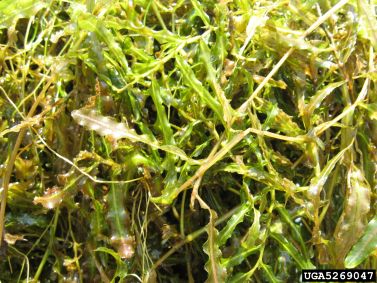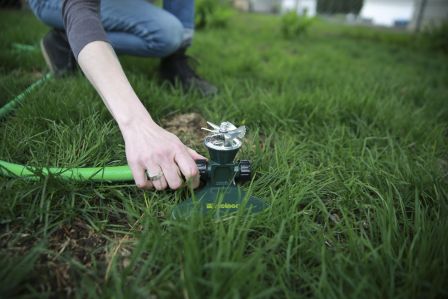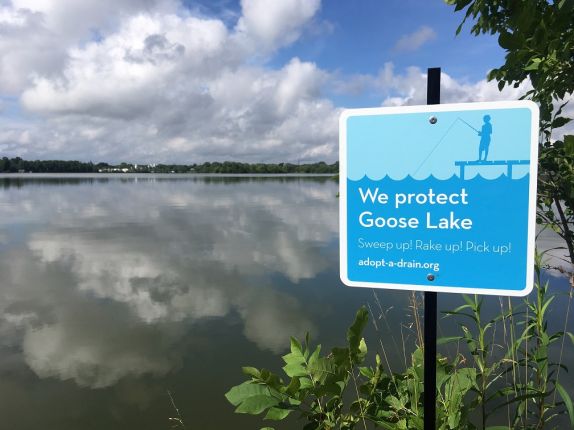Goose Lake Alum & Science Review
In-Lake Focus: Addressing Historical Influence
Historical influence of wastewater discharge and wetland alteration is a major factor in Goose Lake's impaired status. To investigate this issue, the following presentation was given to the VLAWMO Board of Directors at the regular Board meeting on June 26, 2019. In the presentation, staff summarizes current and historical issues surrounding Goose Lake with reference to scientific literature on in-lake treatment options. See the PowerPoint presentation and summary documents below for resources concerning the future of Goose Lake. As seen in the graphs below, monitoring data suggests that visibility of Goose Lake (Secchi disk depth reading in meters) has trended towards improvement in recent years, yet the nutrient composition remains over the State standard. VLAWMO is thankful for the investment, interest, and discussion of everybody involved as we work toward solutions.
- Goose Lake discussion: Meeting Follow-up
- Goose Lake Alum & Science Review: PowerPoint presentation
- Goose Lake Alum & Science Review: Powerpoint Notes
- Goose Lake historical averages: Total phosphorus, Chlorophyll A, Secchi disk
- Goose Lake historical averages: TP and MN State standard
- Stakeholder research range: Map Survey and mail-out available upon request
- Visit the East Goose Lake web page for more data and reports
Out-of-Lake Focus: Addressing the Surrounding Watershed
Reduce the nutrients going into the lake
Best Management Projects (BMPs) such as raingardens, bioswales, sand-iron filters, and underground retention basins collect and treat stormwater before it enters Goose Lake. This helps reduce incoming sediment and nutrients such as phosphorus, which encourages a cleaner, healthier lake. This BMP at Central Middle School in White Bear Lake is an example of a retention basin that was planted as a bioswale above it. VLAWMO and the City of White Bear Lake are seeking invested property owners and managers to partner with for these projects. VLAWMO's cost-share program provides various levels of grant funding for such projects. Visit our grants webpage to learn more. A VLAWMO staff member is available to visit your property for a free, on-site consultation. Click here to view a map of current and recommended BMP locations produced by Barr Engineering.
Adopt-a-Drain
Every curb and stormdrain is lakefront property. Adopting a stormdrain is an easy and effective way for homeowners to help improve Goose Lake. Dozens of residents are already contributing by cleaning leaves, grass clippings, trash, sediment, salt, and other debris out of their nearby drains. Every bit adds up! Visit Adopt-a-Drain.org to get started. Once there, find your nearest stormdrain, give it a clever name, and log your results to help tally the impact of the community effort. VLAWMO and the City of White Bear Lake have teamed up to provide free welcome packets and yard signs (pictured below) delivered to residents and businesses who sign-up in the Goose Lake subwatershed.
Re-establishing native plant species, particularly along shorelines
Native plants are a great option for retaining moisture in the soil and reducing runoff from the landscape. Their deep roots provide valuable structure for soil and nutrients, particularly when planted along a shoreline. The Birch Lake shoreline restoration is an example of a shoreline protection effort made possible by collaboration between citizens, the City of White Bear Lake, and VLAWMO.
Native plants are also a benefit to pollinators such as bees and butterflies. According to the U.S. Fish and Wildlife Service, the Goose Lake subwatershed is within a high potential zone for the endangered Rusty-patched Bumblebee. As Minnesota's new State bee, this provides an exciting opportunity for the White Bear Lake community to contribute to this conservation effort by promoting the use of native plants in parks and yards. Click here to view the USFWS Rusty-patched Bumblebee map.
Controlling invasive Curly-leaf Pondweed
Curly-leaf Pondweed is an aquatic invasive plant from Eurasia, Africa, and Australia. It begins its life cycle early in the year, when ice is still present on the lake. Die-off occurs in late summer. When the plants die, nutrients are released into the water column. Combined with high levels of nutrients already in the lake, this makes for a recipe for strong algae blooms. VLAWMO has started an effort to reintroduce native aquatic vegetation in coordination with the MN DNR.

Practice Water-friendly Lawn Care
Take a moment to plan ahead and develop water-friendly yard habits.
 Photo: Clean Water MN
Photo: Clean Water MN
Examples include:
- Mowing at a height of 3" minimum to encourage deep root growth, moisture retention, and better topsoil coverage.
- If you must fertilize, do so in the fall when grass is preparing for winter. Grass will absorb more in this time of need opposed to spring and summer application. Leave grass clippings on the lawn for a free dose of fertilizer each time you mow.
- Aerate in the fall every few years to boost root depth and infiltrate more water into the soil.
- Avoid weed-and-feed mixtures. Combined applications are often more for convenience than what the yard needs. VLAWMO recommends getting a soil test done to apply according to need. Weeding by hand or allowing a few dandelions is a great way to reduce the risk of herbicide runoff into Goose Lake.
- Keep grass clippings out of the street - mow strategically so that the clippings blow up onto the lawn. Sweep clippings if they do fall into the street.
- Try a bee lawn or an alternative low-mow fescue to reduce maintenance and improve watershed impact.
- Visit our Water Stewardship at Home webpage for more info and tips.


